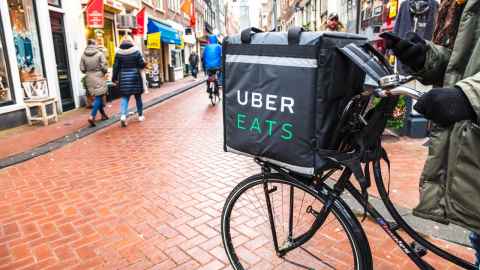Why Uber Eats isn’t doing you any favours
22 November 2022
Opinion: Uber Eats makes ordering food online easier than it has ever been, but having so much food at the tips of our fingers, isn't doing us any favours, says Nisha Mahawar.

Modern technologies have ushered in a new ‘digital food environment’, in which it’s increasingly easy, and normal, to order lunch and dinner online. But it isn’t doing most of us any nutritional favours.
The emerging digital food environment is one of the most influential drivers of food choices to have emerged in recent times. This is particularly the case in younger generations, who live with and depend on these technologies as part of everyday life, the Generation Zs (15-24 year-olds) and Millennials (25-34 year olds), who expect things to happen fast and easily, to fit in with busy and often hectic lifestyles.
Smart phones have given these generations instantaneous access to takeaway food. The online food delivery industry is booming globally, and since Uber Eats reached New Zealand in 2017, demand for such services has only increased here, especially among younger generations. In 2021, every second user of meal delivery services in New Zealand was Generation Z or a Millennial.
The shift to online purchasing of food rather than 'eating out' or 'dining in' has been happening over the past decade, but Covid-19 accelerated this when people across the world were forced to stay at home and began to rely on meal delivery services. Ordering food online became the new normal.
We found that almost three-quarters of the food items sold on Uber Eats in popular Auckland eateries were 'discretionary', or to put it more bluntly, unhealthy.
Before public health professionals have been able to effectively tackle and solve the global burden of obesity and nutrition-related diseases that had emerged from the ‘traditional’ food environment in recent decades, this new digitally-led food world has brought additional challenges for the health risks associated with our obesogenic environment [one likely to cause obesity] and sedentary lifestyles.
One in three New Zealand adults are obese, and the prevalence of obesity has escalated by 21 percent in only the past 10 years. We suspected that online food delivery services, often only a swipe on our phone away, could be making things worse.
To investigate this, we analysed the nutritional quality and marketing tactics of the menu items on Uber Eats, in Auckland. We chose this city because it has high concentrations of 15-34-year-olds. A total of 374 food outlets from 186 suburbs were identified in Auckland, and data for complete menus were collected from the 10 most popular food outlets for each identified suburb. Popular food outlets included independent outlets such as a local kebab shop, and franchise food outlets such as McDonald’s.
We analysed close to 26,000 menu items which were classified into categories based on the Australian and New Zealand Dietary Guidelines. That is, if they were one of the 'five food groups' we should include in our diet (fruit and vegetables, grains, dairy and/or alternatives, legumes/beans, lean meat/seafood, eggs, etc). Or if they were 'discretionary', foods that are low in dietary fibre, vitamins and minerals, high in energy and nutrients that are not a necessary part of the diet, such as saturated fats, sodium and sugars.
We found that almost three-quarters of the food items sold on Uber Eats in popular Auckland eateries were 'discretionary', or to put it more bluntly, unhealthy.
It’s well known that online food delivery services use mouth-watering photos, discounts, combo and meal deals to appeal to customers. We found that unhealthy menu items were twice as likely to be promoted with a photo and five times more likely to include value bundle offers compared to the healthier menu items. Value bundles might increase the total energy content of the meal, but without the nutritional value.
We also found that unhealthy foods are targeted at price-sensitive consumers, and significantly cheaper than the healthier options. This is also concerning as young adults generally have a tighter budget and likely to make their food choices based on cost, rather than health.
So, is Uber Eats bad for us? Based on the results of our study and a similar study done in Sydney, yes, they are. And due to developing technology we can expect a lot more growth in this space, along with the population’s waistlines.
Online food delivery services could and should implement menu kilojoule labelling policies which highlight the total energy content of each menu item, so that consumers can make informed choices at point-of-purchase, about what they’re buying and about to put in their mouth.
Currently, there is no such policy in New Zealand. However, looking at the growing demand for such services, as well as the escalation of obesity and related poor health conditions, there is a strong need for public health policies to dampen the likely effects of the digital food environment on our health, and for the industry to take some responsibility for our collectively widening girth.
Nisha Mahawar is a dietician with the faculties of Science and Medical and Health Sciences.
This article reflects the opinion of the author and not necessarily the views of Waipapa Taumata Rau University of Auckland.
This article was first published on Newsroom, Why Uber Eats isn't doing you any favours, 18 November, 2022.
Media contact
Margo White I Media adviser
Mob 021 926 408
Email margo.white@auckland.ac.nz